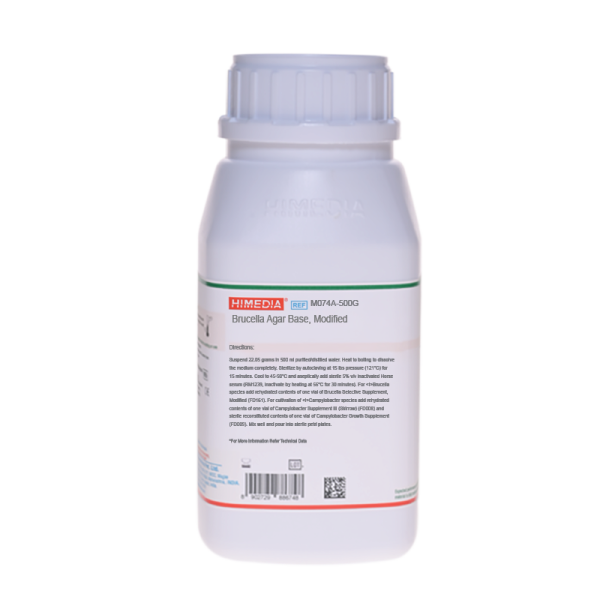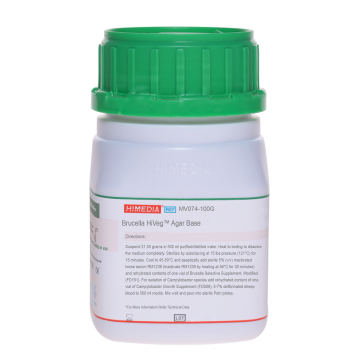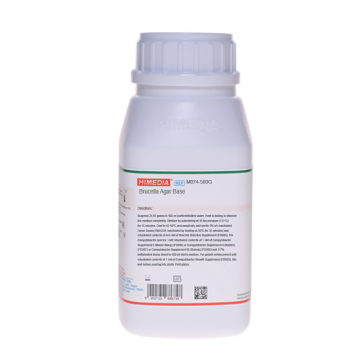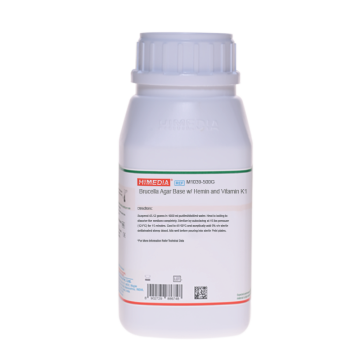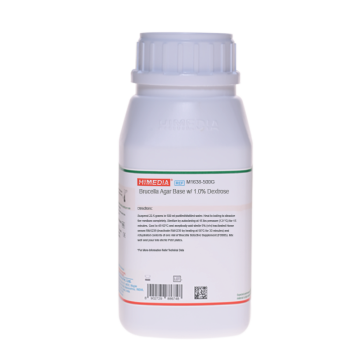 Your enquiry has been submitted
Your enquiry has been submitted
Brucella Agar Base, Modified
Intended Use
Recommended for cultivation of Campylobacter species.
Composition**
| Ingredients | g/L |
|---|---|
| Tryptone | 15.000 |
| Peptone | 5.000 |
| Yeast extract | 2.000 |
| Dextrose (Glucose) | 1.000 |
| Sodium chloride | 5.000 |
| Sodium citrate | 1.000 |
| Sodium bisulphite | 0.100 |
| Agar | 15.000 |
Final pH (at 25°C): 7.0±0.2
**Formula adjusted, standardized to suit performance parameters
Directions
Suspend 22.05 grams in 500 ml purified/distilled water. Heat to boiling to dissolve the medium completely. Sterilize by autoclaving at 15 lbs pressure (121°C) for 15 minutes. Cool to 45-50°C and aseptically add sterile 5% v/v inactivated Horse serum (RM1239, inactivate by heating at 56°C for 30 minutes). For Brucella species add rehydrated contents of one vial of Hexa Selective Supplement, Modified (FD161). For cultivation of Campylobacter species add rehydrated contents of one vial of Skirrow Selective Supplement (FD008) and sterile reconstituted contents of one vial of Minerals Growth Supplement (FD009). Mix well and pour into sterile petri plates.
Principle And Interpretation
This medium is formulated so as to support luxuriant growth of fastidious bacteria like Campylobacter and Brucella species (1).
Peptone, Tryptone provide organic nitrogen to the organisms. Yeast extract also supply some nitrogenous nutrients but mainly it serves as a source of Vitamin B complex. Dextrose serves as an energy source. It can be enriched with 5% v/v sterile defibrinated horse blood. For selective isolation of Brucella species, antibiotic mixtures are incorporated into the base (2,3,4). Farrel and Robinson formulated a highly selective antibiotic medium (5). Ethyl violet and Circulin, which were recommended originally, are no longer used (6). When non-selective medium is required, Brucella Broth Base may be employed with the addition of serum only (i.e. without antibiotics).
It is suggested in case of broth medium that half the tubes be incubated in the normal atmosphere, and half in a 10% CO2 enriched atmosphere. Brucella species are highly infectious and so extreme care should be taken while handling. All presumptive anaerobic organisms must be further confirmed by the tests.
Type of specimen
Clinical material : stool samples
Specimen Collection and Handling
For clinical samples follow appropriate techniques for handling specimens as per established guidelines (7,8).
After use, contaminated materials must be sterilized by autoclaving before discarding.
Warning and Precautions
In Vitro diagnostic use only. For professional use only. Read the label before opening the container. Wear protective gloves/protective clothing/eye protection/face protection. Follow good microbiological lab practices while handling specimens and culture. Standard precautions as per established guidelines should be followed while handling clinical specimens. Safety guidelines may be referred in individual safety data sheets.
Limitations
- C. jejuni is thermophilic and should be incubated at 42°C. Otherwise, growth of colonies may be delayed.
- Campylobacter species require a microaerophilic atmosphere containing approximately 10% CO2 for optimal recovery.
- Further confirmation must be carried out for identification.
Performance and Evaluation
Performance of the medium is expected when used as per the direction on the label within the expiry period when stored at recommended temperature.
Quality Control
Appearance: Cream to yellow coloured homogeneous free flowing powder
Gelling: Firm, comparable with 1.5% Agar gel
Colour and Clarity of prepared medium: Yellow coloured clear to slightly opalescent gel or solution forms in petri plates
Reaction: Reaction of 4.3% w/v aqueous solution at 25°C. pH: 7.0±0.2
Cultural Response
Cultural characteristics observed after an incubation at 35-37°C for 24-48 hours under 10% CO2 with added sterile 5% v/v inactivated horse serum (RM1239).
| Organism | Inoculum (CFU) | Growth | Recovery |
|---|---|---|---|
| Campylobacter jejuni ATCC 29428 (00156*) | 50-100 | good-luxuriant | >=50% |
| Campylobacter coli ATCC 33559 | 50-100 | good luxuriant | >=50% |
| Escherichia coli ATCC 25922 (00013*) | >=104 | inhibited | 0% |
| Staphylococcus aureus subsp. aureus ATCC 25923 (00034*) | >=104 | inhibited | 0% |
Key: *Corresponding WDCM numbers.
Storage and Shelf Life
Store between 10-30°C in a tightly closed container and the prepared medium at 2-8°C. Use before expiry date on the label. On opening, product should be properly stored dry, after tightly capping the bottle inorder to prevent lump formation due to the hygroscopic nature of the product. Improper storage of the product may lead to lump formation. Store in dry ventilated area protected from extremes of temperature and sources of ignition. Seal the container tightly after use. Product performance is best if used within stated expiry period.
Disposal
User must ensure safe disposal by autoclaving and/or incineration of used or unusable preparations of this product. Follow established laboratory procedures in disposing of infectious materials and material that comes into contact with clinical sample must be decontaminated and disposed of in accordance with current laboratory techniques (7,8).
Reference
- Finegold et al (Ed.), 1990, Bailey and Scotts Diagnostic Microbiology, 8th ed., The C.V. Mosby Co., St. Louis.
- Jones L. M. and Brinley M.W.J., 1958, Bull. Wld. Hlth. Org., 19:200.
- Kuzdas C.D., and Morse E.V., 1953, J. Bact., 66 (4):502.
- Renoux G., 1954, Ann. Inst. Pasteur, 87 (3):325.
- Farrell I.D. and Robinson L., 1972, J.Appl. Bact., 35:625.
- Alton G.G. and Jones L.M., 1967, Lab Technique in Brucellosis WHO, Geneva.
- Isenberg, H.D. Clinical Microbiology Procedures Handbook 2nd Edition.
- Jorgensen, J.H., Pfaller, M.A., Carroll, K.C., Funke, G., Landry, M.L., Richter, S.S and Warnock., D.W. (2015) Manual of Clinical Microbiology, 11th Edition. Vol. 1.
| Product Name | Brucella Agar Base, Modified |
|---|---|
| SKU | M074A |
| Product Type | Regular |
| Physical Form | Powder |
| Origin | Animal |
| Packaging type | HDPE |
| References | 1.Moyer N. P., and Holcomb L. A., Laboratory Diagnosis and Infectious Diseases: Principles and Practice, Vol. I, Springer-Verlag, New York2.Smith L. D., and Fient T. A., 1990, Crit. Rev.Microbiol., 17 : 209-2303.Murray P. R., Baron E. J., Jorgensen J. H., Pfaller M. A., Yolken R. H., (Eds.), 8th Ed., 2003, Manual of Clinical Microbiology,ASM, Washington, D.C. 4.Finegold et al, (Ed.), 1990, Bailey and Scotts Diagnostic Microbiology, 8th Ed., The C.V. Mosby Co., St. Louis5.Vanderzant C. and Splittstoesser D. F., (Eds.), 1992, Compendium of Methods for the Microbiological Examination of Foods,3rd Ed., APHA, Washington, D.C. 6.Jones L. M. and Brinley M. W. J., 1958, Bull. Wld. Hlth. Org., 19:200. 7.Kuzdas C. D., and Morse E. V., 1953, J. Bacteriol., 66 (4):5028.Renoux G., 1954, Ann. Inst. Pasteur, 87 (3):325.9.Lapage S., Shelton J. and Mitchell T., 1970, Methods in Microbiology, Norris J. and Ribbons D., (Eds.), Vol. 3A, AcademicPress, London.10.MacFaddin J. F., 2000, Biochemical Tests for Identification of Medical Bacteria, 3rd Ed., Lippincott, Williams andWilkins, Baltimore. |
| Customized Product Available | No |



